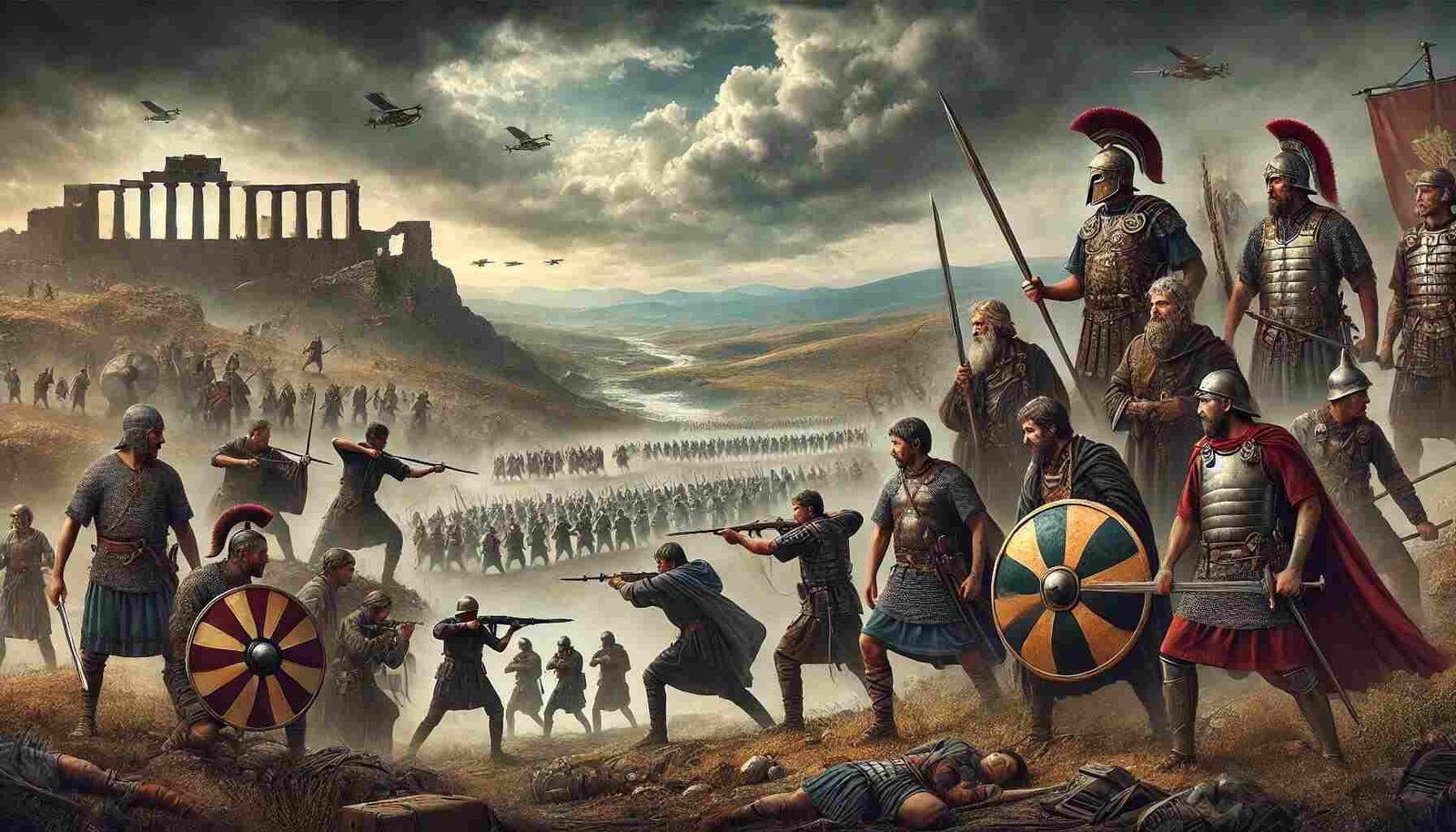Legendary Battles: Epic Clashes That Shaped History

The story of humanity is often told through its conflicts. Battles, whether fought for territory, power, or freedom, have defined nations and altered the course of civilizations. In this in-depth exploration, we’ll journey through some of the most legendary battles in history, examining the strategic genius, extraordinary bravery, and profound impact these battles had on their eras. Each of these legendary battles became a turning point, influencing not only the immediate outcome of wars but also leaving a legacy that resonates through time.
Table of Contents
ToggleWhat Makes a Battle Legendary?
Before diving into these legendary battles, it’s essential to understand what sets a battle apart as “legendary.” Factors that contribute to a battle’s legendary status often include:
- Historical Impact: The battle’s influence on the course of history is crucial. Did it alter borders, end empires, or birth new nations?
- Strategic Brilliance: Many legendary battles are remembered for the military tactics and strategies that were employed, often ahead of their time.
- Heroic Stand or Sacrifice: Battles where armies or individuals demonstrated exceptional bravery and resilience resonate throughout history.
- Cultural Significance: Some battles hold special places in the national or cultural consciousness, symbolizing ideals such as freedom, courage, or endurance.
With these criteria in mind, let’s embark on a journey through some of the world’s most legendary battles, spanning from ancient times to modern warfare.
Ancient Legendary Battles
The ancient world was marked by a series of legendary battles that not only decided the fates of empires but also laid the foundation for military tactics and strategies still referenced today.
The Battle of Kadesh (1274 BCE)
Background
The Battle of Kadesh is one of the earliest and most detailed legendary battles recorded, fought between the Egyptian Pharaoh Ramses II and the Hittite King Muwatalli II. Located near the Orontes River, in what is now Syria, Kadesh was a strategic city that both empires sought to control.
The Course of Battle
This legendary clash involved an array of chariots, which were the most advanced military technology of the time. Ramses II and his forces were initially caught off guard due to misinformation about the location of the Hittite army. However, in a display of tactical ingenuity, Ramses was able to regroup and counter-attack, leading to a standstill that would be remembered as the earliest recorded peace treaty.
Legacy
The Battle of Kadesh stands as a remarkable example of early military diplomacy. Though the outcome was inconclusive, it led to the signing of the first known peace treaty in history, signaling a new era in international relations.
The Battle of Marathon (490 BCE)
Background
The Battle of Marathon took place during the first Persian invasion of Greece and is celebrated as one of the most legendary battles in ancient history. When the massive Persian forces landed at Marathon, the Athenians were significantly outnumbered but managed to pull off a stunning victory.
The Course of Battle
Employing a tactical formation known as the “double envelopment,” the Athenians, under the leadership of General Miltiades, managed to surround the Persian forces, causing chaos and confusion. Despite the Persians’ numerical superiority, the Greeks held their ground, showcasing both superior strategy and fierce determination.
Legacy
This battle gave birth to the legend of the marathon race. According to tradition, a messenger named Pheidippides ran from Marathon to Athens, a distance of about 26 miles, to announce the victory. The Battle of Marathon became a symbol of Greek courage and the beginning of the end for Persian ambitions in Greece.
The Battle of Gaugamela (331 BCE)
Background
Alexander the Great faced his most formidable opponent at Gaugamela, a legendary battle against the Persian Empire led by Darius III. Alexander’s victory at Gaugamela marked the beginning of a new era as he marched towards the creation of one of the largest empires in history.
The Course of Battle
Alexander employed a brilliant flanking maneuver, feigning a retreat that lured the Persian forces into a trap. With his famous cavalry and disciplined infantry, Alexander broke through Persian lines, causing a massive rout. Darius III fled the battlefield, signaling the effective collapse of the Persian Empire.
Legacy
The Battle of Gaugamela is celebrated for its display of Alexander’s tactical genius and the spread of Hellenistic culture across the known world. It marked the beginning of Alexander’s dominance and the establishment of the Macedonian Empire as a significant force in history.
Medieval Legendary Battles
The medieval era was defined by legendary battles that were often brutal and decisive, marking the rise and fall of kingdoms. The battles of this period also reflect the emerging use of advanced siege technology and evolving military tactics.
The Battle of Hastings (1066)
Background
One of the most famous legendary battles of the medieval period, the Battle of Hastings determined the future of the English throne. When King Edward the Confessor died without an heir, a dispute erupted, culminating in this battle between Harold II, the last Anglo-Saxon king of England, and William, Duke of Normandy.
The Course of Battle
William’s forces consisted of a well-balanced mix of infantry, cavalry, and archers. Harold, who had just defeated the Norwegians at Stamford Bridge, was forced to march his army south with little rest. William’s use of feigned retreats ultimately broke the Anglo-Saxon shield wall, leading to Harold’s death and William’s decisive victory.
Legacy
The Battle of Hastings brought about the Norman Conquest, which forever changed the social and political landscape of England. It introduced Norman culture, language, and feudalism, laying the groundwork for the development of modern English society.
The Battle of Agincourt (1415)
Background
The Battle of Agincourt was fought during the Hundred Years’ War, a period marked by intense rivalry between England and France. Outnumbered and deep in enemy territory, the English, under King Henry V, faced a formidable French army on Saint Crispin’s Day.
The Course of Battle
Henry V’s tactical use of the English longbow played a pivotal role in this legendary battle. The longbowmen decimated the advancing French knights, whose heavy armor made them vulnerable in the muddy terrain. The English victory was overwhelming, despite being outnumbered five to one.
Legacy
The Battle of Agincourt has since become a symbol of English nationalism and military prowess, celebrated for its demonstration of strategic ingenuity and the triumph of determination over seemingly insurmountable odds.
The Siege of Constantinople (1453)
Background
The Siege of Constantinople marked the end of the Byzantine Empire and the beginning of a new chapter in world history. Ottoman Sultan Mehmed II laid siege to the city, which was one of the most fortified and culturally significant cities in the world.
The Course of Battle
The Ottomans employed massive cannons and innovative siege techniques to breach the Theodosian Walls that had protected the city for centuries. Despite valiant efforts by the defenders, Constantinople fell after a 53-day siege, signaling the rise of the Ottoman Empire and the end of the medieval era.
Legacy
The fall of Constantinople was a watershed moment, as it marked the end of the Middle Ages and ushered in the Renaissance. It also cut off European access to the Silk Road, prompting the Age of Exploration as European powers sought new trade routes to the East.
Legendary Battles of the Early Modern Era
The early modern era saw legendary battles that shaped the course of empires and colonial powers. These battles also marked the increasing use of naval forces and the rise of modern military strategy.
The Battle of Lepanto (1571)
Background
The Battle of Lepanto was a monumental naval clash between the Holy League, a coalition of Catholic states, and the Ottoman Empire. This battle was significant as it represented a clash of civilizations and a fight for control over the Mediterranean Sea.
The Course of Battle
The Holy League, led by Don John of Austria, confronted the Ottoman fleet off the coast of Greece. Despite the Ottomans’ formidable naval power, the Holy League’s forces, using galleys equipped with cannons, inflicted a decisive defeat on the Ottomans.
Legacy
The Battle of Lepanto was the last significant engagement involving primarily oared vessels and marked the decline of Ottoman naval dominance in the Mediterranean. It was also a victory celebrated across Europe, symbolizing Christian unity against a common adversary.
The Battle of Blenheim (1704)
Background
The Battle of Blenheim was one of the most pivotal battles of the War of the Spanish Succession, fought between the forces of the Grand Alliance (led by the Duke of Marlborough and Prince Eugene of Savoy) and the French and Bavarian forces. This legendary battle took place in what is now Germany
and marked a turning point in the War of the Spanish Succession.
The Course of Battle
The Duke of Marlborough, demonstrating brilliant military tactics, led a combined force of British, Dutch, and Austrian troops against the Franco-Bavarian forces. Marlborough orchestrated a coordinated attack that targeted the enemy’s weak points, managing to outmaneuver and overwhelm the French and Bavarian forces. The Allies encircled the Franco-Bavarian troops, ultimately leading to a devastating defeat for France.
Legacy
The Battle of Blenheim crushed French aspirations for European dominance and secured Britain’s position as a major military power. The victory solidified the reputation of the Duke of Marlborough as one of the great military commanders of his time and shifted the balance of power in Europe. The consequences of this legendary battle reverberated throughout Europe, as it forced France into a more defensive position and prolonged the War of the Spanish Succession.
The Battle of Saratoga (1777)
Background
The Battle of Saratoga is often considered a turning point in the American Revolutionary War. This legendary battle saw American forces, led by General Horatio Gates and Benedict Arnold, face off against the British army under General John Burgoyne. Burgoyne’s objective was to split the American colonies by taking control of the Hudson River Valley.
The Course of Battle
Over the course of two significant battles, the American forces managed to surround and defeat Burgoyne’s army. Thanks to strategic fortifications and effective guerrilla tactics, the Americans not only halted the British advance but also captured a large portion of their forces. The British were forced to surrender, marking one of their most significant defeats of the war.
Legacy
The American victory at Saratoga had far-reaching consequences. It boosted American morale and, crucially, convinced France to enter the war as an ally of the American colonies. The French support provided essential military aid and resources, which helped secure eventual victory for the United States. Saratoga remains a legendary battle that underscores the importance of strategic alliances and determination in the fight for independence.
Modern Legendary Battles
The modern era has witnessed some of the most legendary battles in history, featuring advanced military technology and strategies that have forever altered the geopolitical landscape.
The Battle of Waterloo (1815)
Background
The Battle of Waterloo was the climactic confrontation that ended the Napoleonic Wars. Following his escape from exile on Elba, Napoleon Bonaparte attempted to regain control of France, leading to a showdown with the Seventh Coalition, a European alliance formed to stop him.
The Course of Battle
Napoleon’s forces clashed with a coalition led by the Duke of Wellington and Prussian General Gebhard Leberecht von Blücher. Despite his strategic genius, Napoleon faced fierce resistance from the coalition forces. The timely arrival of the Prussians turned the tide, allowing the coalition to defeat Napoleon’s forces in a grueling day-long battle.
Legacy
The Battle of Waterloo signaled the end of the Napoleonic era and forced Napoleon into permanent exile. The aftermath saw the restructuring of Europe at the Congress of Vienna, which sought to maintain peace and stability through a balance of power among European nations. Waterloo remains a legendary battle, symbolizing the end of an era and the beginning of a new chapter in European history.
The Battle of Gettysburg (1863)
Background
The Battle of Gettysburg was a turning point in the American Civil War, fought between Union and Confederate forces in Pennsylvania. General Robert E. Lee’s Confederate army sought a decisive victory on Union soil, hoping to sway public opinion in the North and encourage foreign intervention.
The Course of Battle
The three-day battle saw intense fighting across several key locations, including Little Round Top, Cemetery Hill, and the infamous Pickett’s Charge. Despite initial Confederate successes, Union forces under General George G. Meade held their ground, ultimately repelling Lee’s assault and inflicting significant casualties on the Confederate army.
Legacy
The Union victory at Gettysburg dealt a severe blow to the Confederacy and marked the beginning of its decline. The battle also led to President Abraham Lincoln’s famous Gettysburg Address, which redefined the purpose of the war and strengthened the resolve of the Union. As one of the most legendary battles in American history, Gettysburg remains a symbol of unity, sacrifice, and the struggle for a just cause.
The Battle of Stalingrad (1942-1943)
Background
The Battle of Stalingrad was one of the bloodiest battles of World War II and a defining moment on the Eastern Front. German forces, under the command of Field Marshal Friedrich Paulus, aimed to capture Stalingrad as part of their campaign to seize Soviet oil fields in the Caucasus. The Soviet Union, led by General Vasily Chuikov, fiercely defended the city.
The Course of Battle
The battle turned into a brutal war of attrition, with both sides suffering staggering casualties. Soviet forces launched a massive counteroffensive, Operation Uranus, encircling and trapping the German 6th Army. After months of relentless fighting and dire conditions, Paulus was forced to surrender, marking a catastrophic defeat for Germany.
Legacy
Stalingrad was a pivotal moment in World War II, as it marked the beginning of the Soviet Union’s advance westward and the gradual decline of Nazi Germany. The victory at Stalingrad boosted Soviet morale and demonstrated the resilience and strategic capability of the Red Army. Today, Stalingrad is remembered as a legendary battle that exemplified the horrors of war and the indomitable spirit of those who fought.
Conclusion: Lessons from Legendary Battles
Throughout history, these legendary battles have not only shaped the political landscape but also taught valuable lessons about strategy, resilience, and the human spirit. They remind us that conflicts, while destructive, can also bring about profound change and serve as catalysts for progress. The bravery and sacrifices made in these battles continue to resonate, reminding us of both the cost of war and the enduring quest for peace.
The legacy of these legendary battles lives on in the lessons they provide to military strategists, historians, and everyday people. They are stories of resilience, leadership, and sacrifice, offering timeless insights into the human experience and the relentless pursuit of freedom and justice.
FAQs on Legendary Battles
1. What qualifies a battle to be considered “legendary”?
A battle is often considered “legendary” if it has had a significant impact on history, showcases extraordinary military strategy, or involves remarkable acts of bravery. Such battles usually have long-lasting cultural and historical significance and are remembered for shaping the course of civilizations.
2. Which ancient battles are considered the most legendary?
Some of the most legendary ancient battles include the Battle of Kadesh, known for its early recorded peace treaty; the Battle of Marathon, which marked a crucial victory for Greece over Persia; and the Battle of Gaugamela, where Alexander the Great’s tactical brilliance led to the fall of the Persian Empire.
3. How have legendary battles influenced modern military strategy?
Many legendary battles provide valuable lessons in tactics, logistics, and leadership that continue to be studied in military academies. Strategies like flanking, feigned retreats, and defensive fortifications seen in historic battles are still relevant and adapted in modern warfare.
4. Why is the Battle of Waterloo so famous?
The Battle of Waterloo, fought in 1815, is famous because it ended Napoleon Bonaparte’s rule and marked the end of the Napoleonic Wars. The battle also led to the redrawing of European borders and the establishment of the Congress of Vienna, which aimed to create lasting peace in Europe.
5. What role did technology play in modern legendary battles?
In modern legendary battles like the Battle of Stalingrad and the Battle of Gettysburg, technology played a crucial role. Advances in weaponry, communications, and transportation significantly influenced battle outcomes and demonstrated how technology can shape military tactics and overall strategy.
Read Previous Article: Apex Legends Chronicle of Valor





